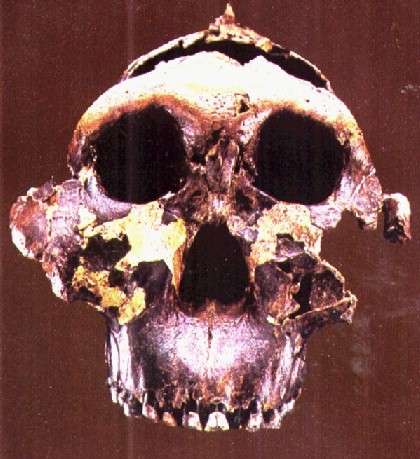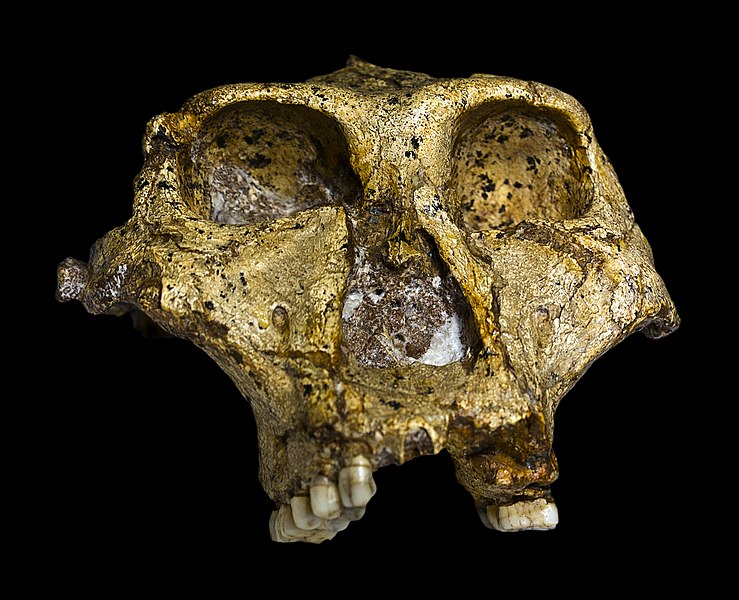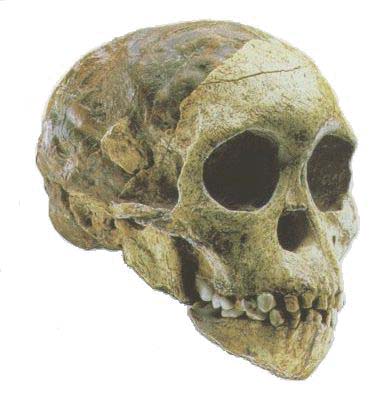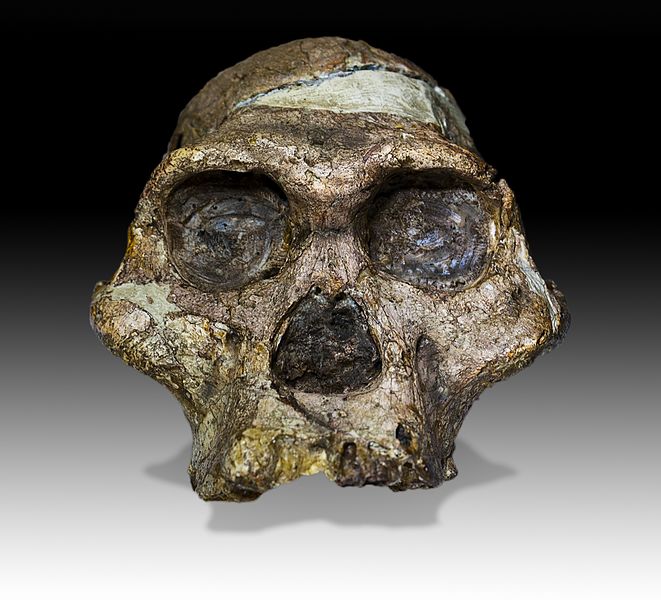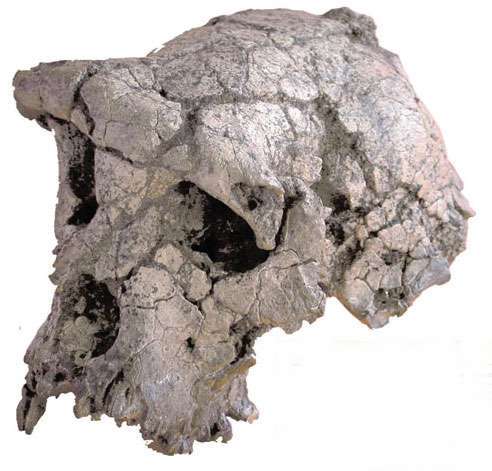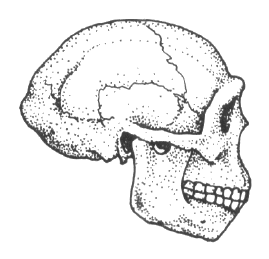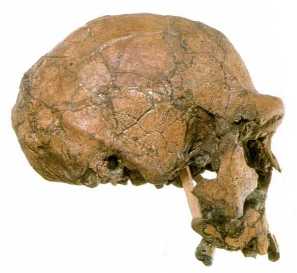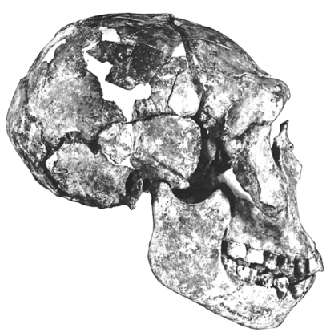Geologist and evangelical Christian Davis Young has expressed his frustration with the refusal of his faith community to even acknowledge the evidence for human evolution, let alone engage with it in any meaningful way:
“The modern evangelical church is extremely sensitive about open discussion of scientific issues that bear on Genesis 1-11. Enough Christians are so afraid of what might turn up in such discussions that anyone who does try to explore the issues is in ecclesiastical jeopardy. The prevailing atmosphere of fear tends to squelch attempts to deal with these issues. The issue of the origin of humankind is especially sensitive. It seems that the church is afraid to look into paleoanthropology. Where is the curiosity about the physical history of human beings? Among the multitude of evangelical commentaries on Genesis, hardly any of them addresses the problems of anthropology. Geology is often discussed. Some of the commentators have admitted the possibility of a local flood; others are not yet sure of the legitimacy of geological findings. But virtually all of the commentators assume the anthropological universality of the flood without any engagement whatsoever with the archeological and anthropological data relevant to the question of the flood’s impact on the human race. It’s as if the hundreds, perhaps thousands of ancient human sites around the world didn’t exist. [1]
David Young’s gloomy observation unfortunately is equally
applicable in my faith community, the Christadelphians. Nearly 50 years ago,
bro. Ralph Lovelock made a brave attempt to acknowledge the evidence for human
evolution and synthesise it with a relatively conservative reading of Genesis. For
his efforts, he was disfellowshipped. Unfortunately, in the forty-seven years
since the arranging brothers in his ecclesia implored our community to solve
these problems “unhindered
by the rumours, mistrust, suspicion and hasty judgments that have been all too
prevalent among us in recent times”, not only has there been no real effort to
address the considerable fossil evidence for human evolution, any attempt to
raise the issue is met with hysteria, bullying, privileging of ignorance over
reason and at times the threat of disfellowship. If we want to avoid losing the
next generation of educated believers and marginalise our community, then we
need to take up the challenge which we’ve shamefully neglected for nearly half
a century.
The
previous post looked at the evidence for large-scale evolutionary change just
in our genus Homo, which stretches back around 2 million years. However, there
are four million years between the human-chimp speciation event and Homo, and
the fossil evidence here is hardly trivial.
Kenyanthropus platyops
- Dated to between 3.5 and 3.2 million years old
- Known from a single skull
- It has a flat plane beneath its nose, giving it a flat face
The poor state of the skull makes assessing its morphology
in detail difficult.
Therefore, some argue that it may be another australopithecine, possibly Australopithecus afarensis which was contemporary.
Australopithecus
sediba
This currently is the most recent australopithecine discovered, dating between
1.78 and 1.95 million years old.
It has been advanced as a possible candidate for the immediate ancestor to the
genus Homo, though the claim is not being stressed.
In body shape, it is generally consistent with other members of the genus Australopithecus.
Elements of the skull, teeth and pelvis resemble Homo, while the upper limbs
are more primitive
Interestingly, some palaeoanthropologists suggested it could be classed in the
genus Homo, while others agree with the classification in the genus Australopithecus. This again is what you would expect with a transitional fossil.
Australopithecus
garhi
Existed between 2 and 3 million years ago. Another candidate for the immediate ancestor of the genus Homo. Post-cranial remains found nearby may belong to it which show a human-like ratio of humerus to femur and an ape-like ration of upper and lower arm.
Paranthropus bosei
Originally classified as Australopithecus
bosei, but increasingly being reassigned to a different genus
Existed between 2.1 and 1.1 million years ago. Compared to other australopithecines, it is markedly robust, and is regarded as being on a branch which did not lead to Homo but instead became extinct.
Existed between 2.1 and 1.1 million years ago. Compared to other australopithecines, it is markedly robust, and is regarded as being on a branch which did not lead to Homo but instead became extinct.
Paranthropus robustus
- Robust species that lived between 2 and 1.5 million years ago
- Its skull is ridged, it has large brows and no forehead
- The mandible is massive with large molars indicating a coarse diet
Paranthropus aethiopicus
- Robust hominid living between 2.7 and 2.5 million years ago
- Large crested skull and heavy cheek bones suited for heavy chewing
Australopithecus
afarensis
- Lived between 3.9 to 2.7 million years ago
- Gracile like its likely descendant A. africanus
- Considered to be also ancestral to the genus Homo
- Remains are that of the famous “Lucy”
Well-preserved skeleton of a 3 year old female member of A. afarensis, known as 'Selam.'
Australopithecus
africanus
Early hominid that lived between 2-3 million years ago. Gracile. Probably on the line leading to the genus Homo. Skull depicted is that of the famous 'Taung Child'
STS 5 or “Mrs. Ples”. Most complete skull of this species found in South Africa
STS 14. Found near STS 5. Unmistakeable evidence of pre-Homo bipedality given the nature of its pelvic
girdle
STW-573 “Little Foot”
- Remarkably complete hominid found between 1994 and 1998 in South Africa
- It includes a complete forearm and hand, most of the lower limbs, skull, pelvis fragments, ribs and vertebrae
- It is still being excavated, so no definitive analysis of the bones has been done
- Approximate date is 2.2 Ma
In general, morphology of the Little Foot suggests a biped which supported the body’s weight on its lower limbs. But it allso reveals a mixture of apelike and humanlike traits; it shows the intermediate condition between human-like total bipedalism and arboreal activity. Talus is the closest bone to human morphology and navicular and medial cuneiform exhibit intermediate morphology, while the anterior of the foot seems more primitive. Tobias (1997) concluded: ‘‘It seems that the astragalus and the proximal ankle joint adopted the human form quite early on, whereas the anterior part of the foot retained its primitive state for a long time’’. The mobility of the big toe (opposable hallux) is an ape like trait. This could point to the (limited) ability of grasping branches while climbing trees, but some studies (Harcourt‐Smith, Aiello 2004) suggested that Little Foot actually could not oppose its hallux. [2]
Ardipithecus ramidus
Lovejoy CO, Suwa G, Simpson SW, Matternes JH, White
TD. The great divides: Ardipithecus ramidus reveals the postcrania of our last
common ancestors with African apes. Science.
Known from fossils including a skull and partial skeleton dating around 4.4 million years ago. The more complete fossil was found in 1994, but only in 2009 was the detailed study released. While no one is claiming it is the common ancestor of chimps and humans, it is the earliest and most complete fossil dating after the split.
It was bipedal, though not as well adapted to walking on the
ground as the later Australopithecines
Its great toe was opposable, allowing it to climb trees
Its great toe was opposable, allowing it to climb trees
Sahelanthropus tchadensis
Known (so far) from a skull dating between 6 and 7 million
years ago
It is not known whether it is bipedal
It is not known whether it is bipedal
Orrorin tugenensis
- Discovered in deposits dated to around 6 million years ago
- One can infer bipedality from the remains.
The fossil evidence for human evidence has only been briefly addressed in these two posts, but it is real, and is compelling. (The fact that many attacks on human evolution made by members of our community are still talking about Piltdown man shows how utterly uninformed and out of date these attacks are.) These remains pose a huge problem for special creation. These are not apes, but neither are they human. We see a trend towards larger skull size and bipedality as we examine the
fossil record..
Furthermore, these fossils are clearly what mainstream science calls
transitional:
- Ardipithecus ramidus clearly is a mix of quadruped and bipedal adaptations
- The Australopithecines are bipedal, but have smaller brains than Homo
- The trend from Homo habilis to Homo sapiens towards larger brain size is also hard to ignore
The trend towards larger brain size over time is
real
This is a perfect example of large-scale evolutionary change. We see an unambiguous trend towards large cranial capacity over time.
When special creationists examine these fossils (or in this case, some of the members of genus Homo), they insist that these are either ape or human. However, when they examined these fossils, there was no agreement among them as to which was 'ape' and which one was 'human':
2. Homo habilis (KNM-ER 1470)
3. "Java Man" - Homo erectus
4. "Peking Man" - Homo erectus
5. Homo erectus (KNM-ER 3733)
6. Homo erectus - "Turkana Boy" (KNM-WT 15000)
Creationists claim these fossils are either ape or man, but they
don't agree among themselves on which is which.
Cuozzo (1998) 1 2 3 4 5 6
Gish (1985 1 2 3 4 5 6
Mehlert (1986) 1 2 3 4 5 6
Menton (1988) 1 2 3 4 5 6
Taylor & Van Bebber (1995) 1 2 3 4 5 6
Lubenow (1992) 1 2 3 4 5 6
Line (2005) 1 2 3 4 5 6
Gish (1985 1 2 3 4 5 6
Mehlert (1986) 1 2 3 4 5 6
Menton (1988) 1 2 3 4 5 6
Taylor & Van Bebber (1995) 1 2 3 4 5 6
Lubenow (1992) 1 2 3 4 5 6
Line (2005) 1 2 3 4 5 6
(References cited in ref 3 of this post).
This is exactly what one would expect to see if these were transitional fossils, showing a mix of primitive and modern features. Jim Foley nails it when he says:
“It could be pointed out that evolutionists also disagree on how fossils should be classified, which species they belong to, etc. True enough. But according to evolutionary thinking, these fossils come from a number of closely related species intermediate between apes and humans. If this is so, we would expect to find that some of them are hard to classify, and we do
“Creationists, on the other hand, assert that apes and humans are separated by a wide gap. If this is true, deciding on which side of that gap individual fossils lie should be trivially easy. Clearly, that is not the case.” [3]
While our community is either talking about "Nebraska Man" and "Piltdown Man", people in our community are encountering this evidence, and asking hard questions:
"As a 1st year uni student studying archaeology and paleoanthropology, I had to undertake a compulsary unit last semester entitled 'Human Evolution'. Probably not a subject I would have enrolled in off my own back, but as I said, a compulary [sic] unit towards my degree.
"Something I did not realise was that in scientific terms, a theory is a hypothesis that has not yet been falsified. Ok, so part of my question is ... As Christadelphians, is it appropriate for us to be holding seminars stating 'Evolution ... it's just a theory'. In essence, if we are going to be promoting evolution as a theory, are we not giving it some form of basis of truth because we are saying it has not yet been falsified.
It hardly needs stressing that pretending the fossil evidence for human evolution does not exist when people such as the above poster are intimately acquainted with the fossil evidence which the science denialists in our community claim is imaginary."Second part of my ramblings is: How do we, as Christadelphians, explain the skeletons found in parts of Africa, Europe, Asia that have been classified as australopithecines, homo erectus and Neandertals? Just interested, thats all. I had to study them all last semester and learn all their differing physical characteristics which was great fun ... NOT :) - [4]
Conclusion
Explaining it away with creationist answers will destroy our credibility as the arguments are poor. We've already seen that creationists can't even agree among themselves as to which fossils are 'ape' and which ones are 'human' so appealing to Answers in Genesis will simply show to those asking these questions that we don't have a clue about the subject, particularly if they have relevant specialist knowledge or access to the primary literature can see for themselves the poverty of such responses.
Nearly fifty years ago, bro. Lovelock was disfellowshipped for trying to resolve this issue. In the intervening half-century, a solid case for human evolution from the fossils has become overwhelming. Patronising people who ask these questions, or threatening them with disfellowship smacks of fear and desperation – do we want to be seen in the same light as the Church was with respect to Galileo?
Credible answers are urgently needed which respect science and the Bible, without resorting to fundamentalist or liberal ways of reading the evidence. In my own small way, I hope to help achieve such a harmony.
References
1. Young D.A. “Young, “Theology and Natural Science,” 13. Cited
in Noll, Mark A. The Scandal of the Evangelical Mind (1994: Eerdmans
Publishing Co) p 232
4. http://www.facebook.com/topic.php?uid=32497162987&topic=12669



